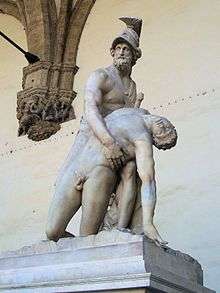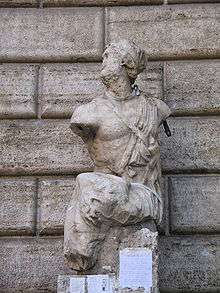Menelaus supporting the body of Patroclus

Menelaus supporting the body of Patroclus (also known as the Pasquino Group) is a marble sculpture known as so due to its apparent representation of an episode in the Iliad featuring the characters Menelaus and Patroclus. The sculpture has had a complex artistic and social history that illustrates the degree to which improvisatory "restorations" were made to fragments of ancient Roman sculpture during the 16th and 17th centuries, in which contemporary Italian sculptors made original and often arbitrary and destructive additions in an effort to complete the lost fragments of the ancient sculptures.[1]
The ancient nucleus of the sculpture, underneath the later additions, initially consisted of the headless torso of a man in armor supporting a heroically nude dying comrade; the group was made in the late 1st century AD, a Roman copy[2] freely reproducing a Hellenistic Pergamene original of the mid-3rd century BC. Another version of the composition, though so dismembered and battered that the relationship is scarcely recognizable at first glance,[3] is the so-called Pasquin, the most famous of the talking statues of Rome. It was set up on a pedestal in 1501.
The sculpture now under the Loggia dei Lanzi in Piazza della Signoria, Florence, (illustration, right) is one of two modified versions of this subject that passed into the hands of Cosimo I, Grand Duke of Tuscany. (The other is in a subsidiary courtyard of Palazzo Pitti. Its history is briefly summarised below.)

The illustrated sculpture was purchased by Cosimo I, not long before 1570, soon after it was discovered in the vigna of Antonio Velli, half a Roman mile beyond Porta Portese, Rome.[4] With the consent of Pope Pius V, it was taken immediately to Florence, where it appears in the inventory taken at Cosimo's death in 1574.[5] The project for completing the truncated torso of the "Menelaus" figure, missing above the waist when it was found according to the Memorie (1594) of the sculptor and antiquarian Flaminio Vacca, was commissioned by Ferdinando II; the "restoration" was worked out by Pietro Tacca and executed by Lodovico Salvetti[6] from Tacca's model, according to Filippo Baldinucci.[7] It was set up in a niche on the south end of the Ponte Vecchio. Paolo Alessandro Maffei's engraving of 1704[8] shows that Menelaus then was wearing a helmet much simpler than the elaborate neoclassical one erroneously provided by Ricci seen on the sculpture today.
In 1771, the neoclassic artist Anton Raphael Mengs took moulds of the parts he considered genuinely ancient (and thus original) of this sculpture and the version at the Palazzo Pitti (discussed below) and reassembled them in a plaster model that was intended to be more faithful to the Roman original.[9] It was taken away to be further repaired in 1798[10] and remained in obscurity, undergoing further adjustments by Stefano Ricci in the 1830s, until it was finally re-erected in 1838, in the Loggia dei Lanzi.[11] The feature which still draws most attention is the lifeless hanging left arm of Patroclus, seemingly dislocated, which was in fact part of the Tacca-Salvetti restoration.[12] Other errors in restoration are the lifted left leg of the bearer, the raised right knee of Patroclus, and the mounded ground that serves as a base.[13]
The second Medici group
The second group of Menelaus supporting the body of Patroclus (not illustrated) was a gift in 1570 from the Florentine Paolo Antonio Soderini of Rome.[14] It was said to have been found at the Mausoleum of Augustus.[15] Identified as Ajax, is stands in the Cortile del Ajaco of Palazzo Pitti.
Further fragments of other Roman copies of this group have appeared during the 20th century,[16] but more severe and careful modern criteria for restoration have led historians to avoid trying to restore them as a completed figural group, as past individuals attempted to do with Menelaus supporting the body of Patroclus.
Notes
- ↑ The sculpture is one of three versions of the "Pasquino" discussed by Francis Haskell and Nicholas Penny, Taste and the Antique: The Lure of Classical Sculpture 1500–1900 (Yale University Press) 1981: 291–96, cat. no 72. "Pasquino"; Giovanna Giusti Galardi, The Statues of the Loggia Della Signoria in Florence: Masterpieces Restored 2002:45–51.
- ↑ Though the sculptors themselves might well have been Hellenes by birth and by training.
- ↑ It was remarked upon as a matter of fact by Flaminio Vacca, Memorie... 1594, quoted in note 4, below; the identification as Menelaus with the dying Patroclus was made by Francesco Cancellieri, Notizie delle due famose statue di un fiume et di Patroclo dette volgarmente di Marforio et di Pasquino (Rome 1789), noted in Haskell and Penny 1981:291 note 2
- ↑ "97. Mi ricordo che fuori della detta porta Portese mezzo miglio, dov'è la vigna di Antonio Velli, vi fu trovato un Pasquino sopra un piedistallo di tufa, con un Gladiatore, che gli muore in braccio; il detto Pasquino era mancante fino alla cintura, ma il Gladiatore sano : e quando venne il Duca Cosmo ad incoronarsi in Roma Gran Duca, lo comprò, per scudi cinquecento, e lo condusse a Fiorenza accompagnatolo con l'altro, che ebbe da Paolo Soderino, trovato nel Mausoleo di Augusto." Flaminio Vacca, Memorie... 1594; see also Rodolfo Amedeo Lanciani, The Ruins and Excavations of Ancient Rome: A Companion Book for Students 1897:547, noting Francesco Cancellieri, Notizie sulle statue di... Pasquino (Rome, 1779).
- ↑ Haskell and Penny 1981:294-95 note 23.
- ↑ Lodovico Salvetti, like Tacca a former garzone in the studio of Giambologna, was a minor Florentine sculptor who worked as Tacca's assistant.
- ↑ Baldinucci, Notizie dei professori del disegno... ii:168.
- ↑ Included in Maffei's Raccolta di statue antiche e moderne, plate xlii (Rome, 1704).
- ↑ Galardi 2002.
- ↑ After the Treaty of Tolentino (February 1797) Napoleonic agents were assessing all the public and noble collections of Italy to see which antiquities should be removed to Paris. Many of the antiquities of Naples were removed by ship to safety in Sicily by the Neapolitan Bourbons in exile.
- ↑ Haskell and Penny 1981:295-95; earlier discussions of placing it in the Loggia dei Lanzi had never been acted upon.
- ↑ "In fatti nel gruppo del Ponte Vecchio il torso della prima figura, ed il braccio sinistro della seconda è moderno." (Saggio istorico della Real galleria di Firenze (1779) vol. ii note xxxv to p. 20.
- ↑ Pointed out by Erna Mandowsky, "Two Menelaus and Patroclus Replicas in Florence and Joshua Reynolds" The Art Bulletin 28.2 (June 1946:115–118) p. 115.
- ↑ According to Flaminio Vacca, Memorie di varie antichità trovate in diversi luoghi della Città di Roma, 1594 (Haskell and Penny 1981:295).
- ↑ For Soderini's archaeological activities at the Mausoleum of Augustus, see Anna Maria Riccomini, "A Garden of Statues and Marbles: The Soderini Collection in the Mausoleum of Augustus" Journal of the Warburg and Courtauld Institutes 58 (1995, pp. 265–284) p. 281f.
- ↑ Bernhard Schweitzer listed all the fragments known as of 1936, in "Das Original des sogennanten Pasquino-Gruppe", on Abhandlungen der philologisch-historischen Klasse der sächsischen Akademie der Wissenshaften 43.4 (Lepzig) 1936:1ff; he reported the particular parts of the two Medici groups that are restorations.
External links
![]() Media related to Pasquino Group at Wikimedia Commons
Media related to Pasquino Group at Wikimedia Commons
Coordinates: 43°46′09″N 11°15′20″E / 43.76917°N 11.25556°E
_01.jpg)